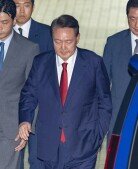Live Report from Baghdad, Iraq
The headquarters of the Ba`ath Party which has been supporting the reign of Saddam Hussein is located next to the National Assembly building in the city of Baghdad. With two U.S. Army tanks guarding the nine-story building on April 18, the atmosphere is very dreary. The headquarters, despite its history of visits by high officers of the Ba`ath Party, could not escape the plundering of people as in other government buildings.
The U.S. Army placed an armored car at the entrance to the headquarters, blocking the Iraqis as well as reporters from entering the building. “When we arrived here four days ago, the building was already emptied out due to looting,” said Sergeant Robert Boll of the U.S. Third Infantry Division. Nevertheless, he even blocked the entrance surrounding the building with a warning, “We can’t guarantee people’s safety.”
The regional office of the Ba`ath Party is located on 4.28 Street, named after the birthday of Hussein, April 28. Seven rooms on the 2nd floor of the building were used as offices of the Ba`ath Party. These offices ‘managed’ around 2,000 residents living in the nearby commercial regions. This division was called ‘Percha’, the lowest level of the Ba`ath Party organization, the one closest to the residents. Following Percha, ‘Shaaoba’ and ‘Para’ take the next levels of the organization respectively and at the top, the controlling division called ‘Al Queda Kotrie’, controlled residents with perfect order.
There is no doubt that the regional office at ‘4.28 Percha’ has collapsed beyond its physical appearance. These offices have been emptied and looted of their chairs and desks. A ranking chart of the Percha and an action principle chart still hang on a wall at the entrance to an office, and there are women’s educational documents scattered all over the place in another office. Nevertheless, portraits of Saddam Hussein still hang in many of the offices.
“At the beginning of the war, all of the 100 members of the party fled to the provinces outside of Baghdad. The Ba`ath Party has ended. It has completely vanished,” stated Kalid Paruk (28 years of age) who was a middle status officer of the Party. Mr. Paruk, a member of the Republican Guard, had fled to a province and had returned to Baghdad about a week ago. He said that the most of the remaining members have now scattered all over the country.
What does this really mean for the Ba’ath Party, which had been ruling Iraq for 40 years, to be captured by the U.S. Army? Does it mean that the basic principles of the Ba’ath Party, the unity and freedom among Arabs opposing colonialism, will disappear?
The formal name of the Ba`ath Party is the Ba`ath Arab Socialist Party. The party has its roots in a revivalist movement for Arabs that started in Syria in the 1930s. The urgency of the need to strengthen Arabic heritage in order to prevent further defamation of Arabic principles by the colonialism of Britain and other Western countries, spread among the educated elite who had been paradoxically educated in those western nations.
The Ba`ath Movement took on the nature of a political organization in the beginning of the 1940s and in 1947, a political party formed in Damascus, the capital of Syria. The branch in Iraq was established in 1954 and successfully seized power in 1963. The Ba’ath Party was then able to penetrate the general populous more easily with the voice claiming that the reason why Palestine handed over land to Israel was due to Arabs not being able to unite.
However, ‘absolute power will absolutely corrupt’. Hussein provided various benefits to the members of the party but he completely neglected the other parties. As the deprived citizens increasingly complained about the party, the Ba`ath Party strengthened control and became as it now stands today.
Who can fill the emptiness in power of the Ba`ath Party now since the time of the attack and occupation of the United States?
There is a public plaza called “firdus”(means paradise) next to the Sheraton Hotel, where reporters usually stay. The protestors have taken over the place where an enormous statue of Hussein once stood with placards saying, ‘Iraqi government by the hands of the Iraqis!’
There are posters of Massoud Al Barzani, the top Kurdish leader, and his achievements on the walls of the plaza. The names of Ahmad Chalabi and Bakru Al Hakim, known as leaders of the future government as named by the United States, cannot be seen anywhere. As rumors about the return of Mr. Chalabi to Baghdad spread throughout Iraqi, some even shouted, “Chalabi is an American spy”. The recent reaction of Chalabi distancing himself from the American government seems to be because he realizes pubic sentiment.
The museum of the Ba`ath Party is located in the Ali Al Saleet region in Baghdad. Broken frames holding the political histories of Hussein are scattered all over the floors during citizen-led looting. Dozens of guest books were also found under the rubble.
“It is my honor to be at this enormous historical site. I thank the museum for preserving the historical materials of the leader, Saddam Hussein and the Ba`ath Party.”
This is an impression of a visitor in 1990. The ‘adversity’ of Hussein started this year when he invaded Kuwait. What kind of impression would this visitor have had if he/she revisited the museum?
There are ‘new owners’ at the museum. The entire 11 members of poor Mr. Kalaf Hassen’s family are now squatters at the museum come in search of a place to sleep. “We were driven out of our house because the landlord increased our rent. There is no problem of staying here since we have the U.S. Army`s permission,” he boldly stated. Such expression would not have been possible during the period of the Ba`ath Party.
Rae-Jeong Park ecopark@donga.com







